From weak narrative to shrinking valuation, analyzing the current challenges and opportunities of crypto infrastructure

転載元: panewslab
05/07/2025·5DAuthor: Yiping @IOSG
Challenges facing Crypto infrastructure
Market fatigue and valuation decline
The cryptocurrency infrastructure sector is experiencing significant market fatigue. After years of explosive growth, infrastructure projects are shrinking and investors are becoming more picky. This trend reflects an increasingly mature market where technological innovation alone is no longer enough to obtain high valuations.
Innovation Issues
Today’s infrastructure projects face a key dilemma: most offer similar functions with minimal differentiation. Despite technological advancements, we have not seen breakthrough use cases that can support a completely new category of application. The ecosystem has difficulty providing a compelling value proposition for established Web2 platforms such as X or Instagram to migrate them to blockchain. Apart from decentralization, there is little reason for these platforms to revolutionize the existing operational approach. This fundamental adoption gap makes trading and speculation the dominant applications of most infrastructure levels, limiting the potential for change in the field.
Infra over-construction, infrastructure vacant
Many infrastructure projects usually focus on pursuing forward-looking technological innovations and ignore the actual needs of developers. They tend to focus too much on elements beyond the core functions, such as privacy protection, trust assumptions, verifiability, and transparency. This too advanced technical route ignores the importance of short-term market acceptance and practical application, which not only increases the difficulty of early marketing promotion, but also makes it difficult for projects to obtain effective user feedback and verification.
The surge in infrastructure projects of this type has created a contradiction—too many platforms compete for too few attractive applications. This imbalance has led to a large number of "ghost chains" with extremely low actual usage and almost no revenue generation, creating an unsustainable economic model that relies primarily on token appreciation rather than real practicality.
For example, although ZKVM technology is quite advanced, the verifiability it provides cannot effectively solve the actual challenges faced by blockchain at this stage, nor can it promote the integration of more Web2 applications and blockchain technology. Therefore, ZKVM technology is currently more an idealized rather than a practical infrastructure product.
In contrast, cloud computing directly responds to the proven demand in the market, that is, how to efficiently manage server resources in different configurations, different times and locations. This requirement itself has a relatively mature market foundation, and the cloud computing platform directly meets the actual demands of developers in terms of rapid deployment, flexible expansion and cost optimization through modular and interfaced server resources, database management and storage services. It is precisely because it has effectively solved the pain points of enterprises and developers that cloud computing technology has quickly gained market recognition and eventually developed into an important infrastructure to support the Internet economy.
Break the feedback loop
A healthy crypto ecosystem requires an efficient feedback loop between application developers and infrastructure builders. Currently, the cycle has broken down – application developers are plagued by infrastructure constraints, and infrastructure teams lack clear signals to understand which features can drive actual use. Restoring this feedback mechanism is crucial to sustainable growth. Despite these challenges, infrastructure development remains lucrative, with 35 of the top 50 cryptocurrencies in market cap maintaining their own infrastructure tiers. However, the criteria for success have been greatly improved – new infrastructure projects must simultaneously demonstrate specific use cases, a large number of user appeal and compelling narratives in order to achieve meaningful valuations.
The most successful new infrastructure in the past year
The evolution of blockchain infrastructure
Previous cycles of blockchain infrastructure focused primarily on addressing the limitations of Ethereum, with projects positioning themselves as “faster and cheaper” alternatives, while providing little to no truly innovative capabilities. Today, the landscape has changed dramatically, with the recent successful projects introducing more diverse and specialized infrastructure solutions.
The most influential new project
Over the past year, some infrastructure projects have achieved remarkable results through TGE or large-scale financing rounds. According to Cryptorank data, these projects represent the most influential new infrastructure in the primary and secondary markets:
Blockchain infrastructure
- Movement: MoveVM Ethereum Layer2
- Berachain: Liquidity Proof, EVM compatible Layer1Monad: High-performance EVM compatible Layer1
- Solayer: Re-staking based on Solana ecosystem, ultra-high-speed SVM
- Succinct: ZK Proof Generation Network and ZKVM
Emerging infrastructure
- Walrus: Blob storage solution
- Aethir: GPU computing network
- Double Zero: Decentralized Physical Fiber Network Facilities
- Eigenlayer: Provides Ethereum security for new protocols
- Humanity: Digital Identity Protocol Platform
Bridges for Web2 and Web3
- Ondo: RWA Layer2
- Plume: RWAFi Blockchain
- Story: an artificial intelligence-driven IP programmable platform
The following is an overview of the project data (the data as of 2024/4, for reference only):
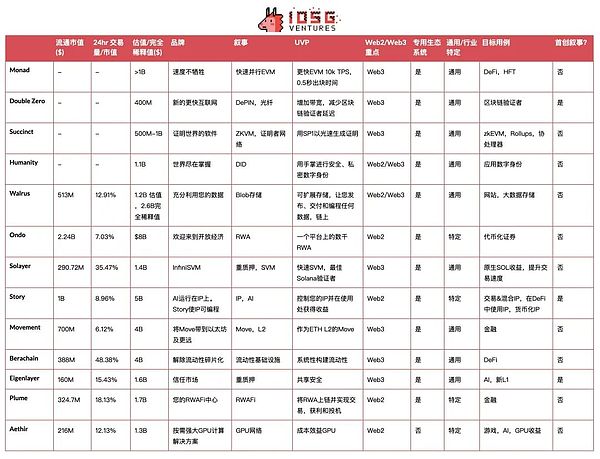
Core observation and analysis
Based on the analysis of recent successful infrastructure projects and combined with the current market environment, the following core observations can be extracted:
Market maturity and valuation reshaping: from technology fanaticism to value return
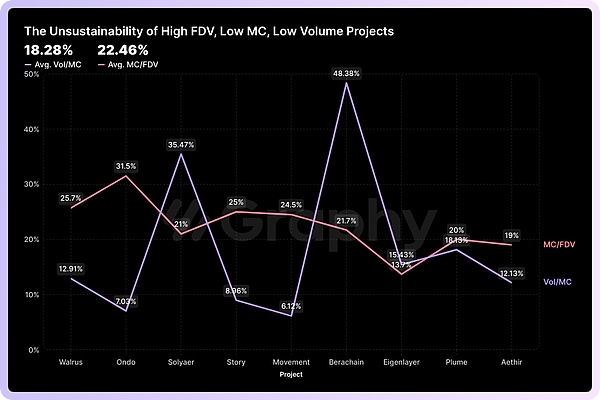
The most significant feature of the current market is the shift in valuation logic. The early model of simply relying on technical narratives and high FDV (completely diluted valuation) to attract investment is facing severe challenges.
Unsustainable token economic model
Many projects show the characteristics of high FDV, low circulating market value (MC) and low trading volume. This indicates that the unlocking of a large number of tokens in the future will bring continuous selling pressure. Even if the project makes technological progress, the price may fall due to token dilution, which will in turn erode user confidence and form a negative feedback loop. This shows that a sound and sustainable token economic model is crucial to the long-term health of infrastructure and is no less important than the technology itself.
Valuation Ceiling and Exit Challenges
Even successful projects seem to face an invisible cap of about $10 billion. This means that for investors, achieving excess returns (such as 100 times) requires entry in the very early stage (valuation below $50 million), highlighting the importance of timing and early judgment. The market no longer easily pays for pure potential, but requires a clearer proof of value.
Execution overwhelms first-mover advantage
Not all projects that create new narratives can get the highest valuation. For example, while Double Zero, Story, and Eigenlayer are pioneers in their respective fields, many subsequent projects have achieved considerable or even higher valuations through stronger execution, better market timing or more optimized solutions. This shows that in an increasingly crowded market, high-quality execution, effective market strategies and grasp of the timing are becoming increasingly prominent.
The rise of technical pragmatism: Focusing on optimization, integration and real needs
The technological development direction of infrastructure shows a clear pragmatic tendency, and the market prefers solutions that can solve practical problems, optimize existing paradigms, or effectively connect to the real world.
The continuous value of “faster and cheaper”
Despite the market's pursuit of breakthrough innovation, the demand for optimization of core blockchain performance remains strong. Projects such as Monad, Movement, Berachain and Solayer have achieved significant valuations by improving the performance of existing virtual machines (EVM, MoveVM, SVM) rather than introducing new paradigms. This suggests that improvements to speed, cost, and efficiency remain core value points for infrastructure until the next generation of killer applications are found. Network layer optimization (such as Double Zero) and security enhancements (such as Succinct, Eigenlayer) also fall into this category.
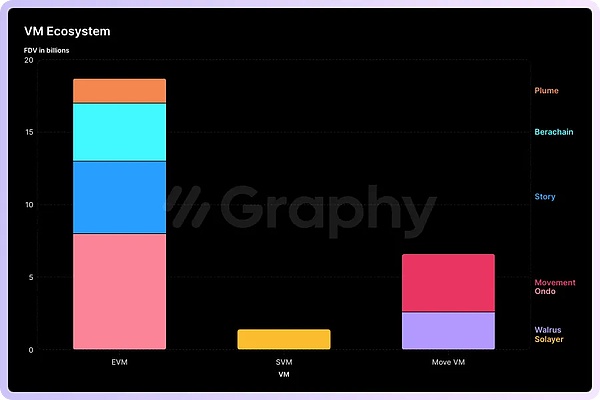
Embrace the real world and connect to Web2
Projects that align with real-world applications and assets show strong market appeal. Ondo and Plume focus on RWA (real-world assets), and Story focus on the programmability of IP (intellectual property), and these projects have all received high valuations. They apply blockchain technology to proven Web2 concepts (such as asset management, IP commercialization), and inject programmability, global liquidity and new financial possibilities into it, lowering the threshold for users' understanding and broadening application scenarios.
DeFi and AI become value anchors
From the perspective of target use cases, finance (DeFi, RWA) and artificial intelligence (AI) are the two most recognized areas currently in the market and can support high valuation infrastructure. This shows that infrastructure that can provide underlying support to these two high-potential areas is easier to gain favor from capital and markets.
Some new narratives are cold
Meanwhile, some infrastructure narratives that have been highly anticipated, such as pure game chains, Rollup-as-a-Service (RaaS), dedicated verification layers, multi-VM chains, Agent chains, partial DePINs and Desci, have not yet produced a billion-dollar leading project in this cycle. This may reflect that these areas are either inadequate technological maturity or have not yet found clear, large-scale market demand and sustainable business models.
Ecological collaboration and precise narrative: a dual engine for amplification of value
In addition to technology and market positioning, building a strong ecosystem and conducting effective market communication has become a key lever for the success of infrastructure projects.
Network effects of ecosystems
The vast majority of projects with a valuation of over $1 billion are committed to building or integrating a dedicated ecosystem. Whether L1/L2 attracts developers to build applications or provides shared security for other protocols like Eigenlayer, it reflects the importance of network effects. An ecosystem with multiple composable projects can create value far beyond isolated solutions, form a positive cycle, and attract more users, developers and capital.
Layered narrative, precise communication
Infrastructure needs to be aimed at two core groups: end users and developers at the same time, and their needs and concerns are completely different. For end users, complex technologies need to be transformed into intuitive "experience" stories (such as fast transaction speed, low cost, and easy use), emphasizing the direct benefits brought by technology. For developers, they need to explain the "capabilities" of the technology (such as performance indicators, development tools, scalability, and security) in depth, and provide professional and accurate information for evaluation. Successful projects can often adjust communication strategies based on different audiences and effectively convey value propositions.
Future investment opportunities for blockchain infrastructure
Targeting the unserved Web2 market
The most promising infrastructure opportunities will target large Web2 markets where blockchain solutions are not fully serviced. These projects can create globally accessible markets while introducing improved financialization mechanisms.
Create new infrastructure categories
A brand new infrastructure category will generate significant value compared to incremental improvements in existing infrastructure, such as:
- Intent-based infrastructure: A protocol that enables users to express desired results rather than specific transactions, automatically processing and performing optimizations.
- Add privacy to every blockchain, Web3's HTTPS infrastructure
Infrastructure to meet user needs and stabilize income
As the blockchain industry matures, the long-term value of infrastructure is gradually returning to its core function: meeting real user needs and generating sustainable revenue. The early market boom may be based on expectations and technical narratives, but ultimately, infrastructure that cannot effectively serve users and build a robust economic model will be difficult to maintain.
Continuous revenue streams are the blood of the healthy operation of the project. They not only need to cover high operating costs, but also provide actual returns to ecological participants (such as token holders, validators), such as token repurchase, incentivize participants, etc. Currently, some head L2s such as Base, Arbitrum has achieved considerable agreement revenue. Base annual handling fee is $27.5M, and Arbitrum and OP are around $7M. However, due to the change in investor preferences this cycle, its token price is still at a relatively low level, reflecting the mismatch between income and valuation. Currently the head Layer2 FDV is 500x of annual agreement revenue. They are fixing this mismatch through measures such as buying back coins.
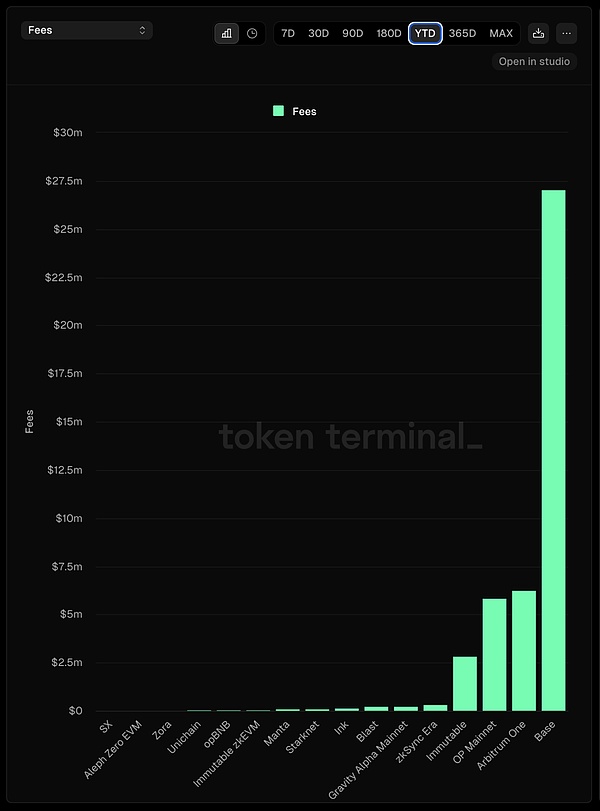
Infrastructure lacks revenue support, it relies more on selling tokens to maintain team operation. This strategy is difficult to resist market cycle fluctuations. Stable income is a direct proof of the market's solution to practical problems and provide effective services. For developers, infrastructure can achieve complex use cases that have been widely used in a hundred times more efficient manner, or implement functions that have not been implemented in the past; for end users, it can bring a smoother experience, lower usage costs and richer functions.
Web2 APP Actively integrates blockchain
Creating a revolutionary application from scratch requires a lot of time and resources. A more efficient approach to emulate the recent AI revolution: Directly integrating blockchain capabilities into existing Web2 applications. The amazing speed of AI adoption is not driven primarily by standalone AI applications, but by thousands of established platforms integrating AI capabilities into existing user experiences.
Therefore, blockchain infrastructure must prioritize seamless integration approaches so that Web2 applications can gradually implement blockchain capabilities without interfering with their core user experience. The most successful infrastructure will enable familiar applications to provide ownership, transactions and financial capabilities without requiring users to understand complex blockchain concepts or navigate new interfaces.
Financial incentives may drive this wave of integration. Just as AI capabilities help Web2 companies create advanced hierarchies and new revenue streams, blockchain integration can unlock new monetization models through tokenization, partial ownership, and programmable royalties. Making these benefits easy to access infrastructure while minimizing technological complexity will catalyze the next stage of adoption of blockchain in mainstream applications.

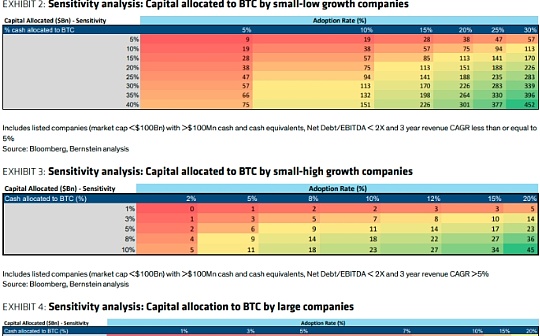
 jinse
jinse
 chaincatcher
chaincatcher
